- More than 2 years ago
Even the most brilliant innovators get their inspiration from somewhere.
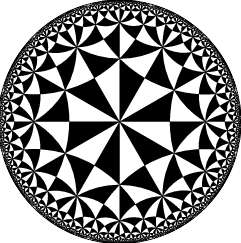
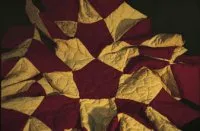
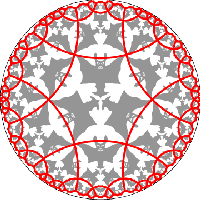
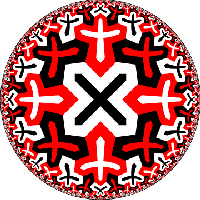
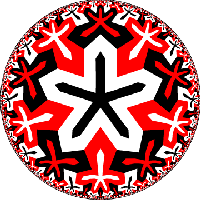
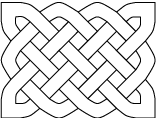
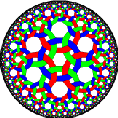
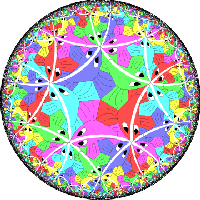
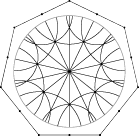
For the Dutch graphic artist M.C. Escher, such a creative impetus came from a particular illustration in a 1957 mathematical article about symmetry. It gave him what he later described as “quite a shock” and inspired him to create four artworks: the Circle Limit series of prints.
The illustration showed a curious tiling of black and white triangles with curved sides. Enclosed within a circle, the alternately colored triangles became progressively smaller as they approached the circle’s perimeter.
The concept of infinity had long intrigued Escher, and he had sought to capture this elusive notion in visual images. One strategy that he employed was to create repeating patterns of interlocking figures. Although Escher could imagine how such arrays could extend infinitely, the actual patterns he drew, of course, represented only a fragment of an infinite expanse.
In another approach, Escher tried to fit together replicas of a figure, such as a fish, that diminish in size as they spiral into or recede from a point in the middle of a square or circular frame. However, he wasn’t entirely satisfied with these efforts.
The mathematical drawing—an illustration of the so-called hyperbolic plane—that had so startled Escher offered him a precise, aesthetically pleasing way to depict diminishing figures within a circle.
The article containing the diagram had been written by H.S.M. Coxeter, a mathematician at the University of Toronto. Today in his nineties, Coxeter continues to focus on the interplay of symmetry and geometric shapes. His research covers topics such as the mathematics of kaleidoscopic patterns.
Coxeter had sent Escher a copy of his symmetry article as a thank you for permission to reproduce several of Escher’s periodic drawings as illustrations. The men had met in 1954 in Amsterdam at the International Congress of Mathematicians, where there was an exhibition of Escher’s work. That encounter led to correspondence between the two, which continued until Escher’s death in 1972.
Escher in 1958 mailed Coxeter a print of “Circle Limit I”—the first fruit of the artist’s venture, inspired by Coxeter, into hyperbolic geometry. In the decades since Escher’s initial foray, the Circle Limit prints have motivated many mathematical investigations and artistic endeavors. Each year, mathematicians and computer scientists continue to add to the literature of hyperbolic tilings and related mathematical topics.
Basic principles
Despite the many manifestations of Escher-inspired research, it all stems from the same basic principles of curved geometry.
For example, if you draw any triangle on a sheet of paper and add up its three angles, the result is always 180 degrees. When you draw a triangle on a saddle-shaped surface, however, the angles invariably add up to less than 180 degrees.
Just as a flat surface—like that of a sheet of paper—is a piece of the infinite mathematical surface known as the Euclidean plane, a saddle-shaped surface can be thought of as a small piece of the hyperbolic plane. Picturing what the hyperbolic plane looks like on a larger scale, however, requires some mind-bending ingenuity.
Freelance mathematician Jeffrey R. Weeks of Canton, N.Y., suggests making “hyperbolic paper” from a large number of equilateral triangles as one way to get a feel for the hyperbolic plane.
Taping together equilateral triangles so that precisely six triangles meet at each vertex produces a flat sheet. In contrast, assembling equilateral triangles so seven triangles meet at each vertex produces a floppy, bumpy surface. The more triangles you use and the larger the resulting sheet, the more closely it resembles the hyperbolic plane.
A similar construction can be done with pentagons. Mathematician and sculptor Helaman Ferguson of Laurel, Md., has made an intriguingly wrinkly hyperbolic quilt by sewing together pentagonal patches of fabric so that four pentagons meet at each corner. It’s an unruly blanket that refuses to lie flat, he says.
Such constructions are not the only way to visualize the hyperbolic plane. More than a century ago, French mathematician Henri Poincaré introduced a method for representing the entire hyperbolic plane on a flat, disk-shaped surface.
In Poincaré’s model, the hyperbolic plane is compressed to fit within a circle. The circle’s circumference represents points at infinity. In this context, a straight line, meaning the shortest distance between two points, is a segment of a circular arc that meets the Poincaré disk’s circular boundary at right angles.
Although this model distorts distances, it represents angles faithfully. The hyperbolic measure of an angle is equal to that measured in the disk representation of the hyperbolic plane. So, a repeating pattern made up of identical geometric shapes in the hyperbolic plane transforms, when represented in a Poincaré model, into an array of shapes that diminish in size as they get closer to the disk’s bounding circle.
For his Circle Limit prints, Escher worked out the underlying rules of these disk models and developed his own method for constructing a hyperbolic grid, relying on his skill and intuition to create the geometric scaffolding he needed. Coxeter’s “hocus pocus” mathematical text wasn’t much help, Escher later remarked in a letter to Coxeter. Nonetheless, Escher executed the drawings with extraordinary accuracy, Coxeter comments.
“The first time I saw a print of ‘Circle Limit III,’ I said to myself, ‘that is the most beautiful example I have ever seen of the Poincaré circle model for hyperbolic geometry,'” says J. Taylor Hollist, a mathematician at the State University of New York at Oneonta. He’s documented many historical interactions between Escher and scientists.
Besides its beauty, “Circle Limit III” also presents a puzzle. For some reason, in this particular case, Escher drew a pattern of lines somewhat different from that in Coxeter’s original drawing. The main arcs seen in “Circle Limit III” meet the circumference at a specific angle very close to 80 degrees rather than precisely 90 degrees.
Coxeter was able to demonstrate that each arc is of a type known to mathematicians as an equidistant curve. It bears the same relationship to a hyperbolic straight line as a line of latitude does to the equator on the surface of a sphere.
When Coxeter worked out trigonometrically what the proper angle of such a curve in Escher’s print should be, he obtained 79 degrees 58 minutes, again confirming the accuracy of Escher’s draftsmanship.
Useful vehicles
Besides intriguing professional mathematicians, Escher’s Circle Limit prints and their repeating patterns prove to be useful vehicles for becoming comfortable with and teaching hyperbolic geometry, says Douglas J. Dunham of the computer science department at the University of Minnesota at Duluth. “Even to mathematicians, hyperbolic geometry is not that familiar,” he contends.
Dunham and his students have written several computer programs to generate hyperbolic patterns, particularly those made up of repeating motifs colored in various ways.
Mathematicians use a standard notation for describing a mosaic made up of identical tiles, where each tile is a polygon with a given number of edges of the same length and the same number of corners or vertexes. On a flat surface, there are three such tilings. A tiling in which six equilateral triangles meet at each intersection is designated {3,6}, one in which four squares meet at each intersection is {4,4}, and one in which three hexagons meet at each intersection is {6,3}.
The same notation applies to regular tilings of the hyperbolic plane. A tiling where four pentagons meet at each vertex is labeled {5,4}. In general, for polygons with p sides, meeting q at a vertex, the result is a hyperbolic tiling when (p – 2) multiplied by (q – 2) is greater than 4.
Escher’s “Circle Limit IV,” which features interlocking devils and angels, is an example of a {6,4} tiling. In other words, the underlying hyperbolic grid consists of hexagons that meet four at each vertex.
Dunham has developed a computer program that transforms a hyperbolic Escher design from one tiling pattern to another. For example, he can transform the {8,3} pattern of crosses in “Circle Limit II” into a strikingly different {10,3} tiling, where the central figure is a star.
The same pattern can be transformed into an array of starbursts with any number of rays, Dunham notes. Indeed, there is an infinite number of hyperbolic tilings available for such transformations. The use of different motifs and color schemes increases the possibilities even further.
At a conference on mathematical connections in art, music, and science held last summer at Southwestern College in Winfield, Kans., Dunham described a novel extension of some of these ideas. He had worked with Celtic knot patterns, used centuries ago in Ireland and elsewhere to decorate religious texts. Such knots are formed by weaving a ribbon into an alternating over-and-under pattern, then joining the two ends to form a continuous band.
Dunham now has a computer program that generates intriguing hyperbolic versions of these ancient designs. He can also construct examples in which rings interlock in the over-and-under pattern characteristic of Celtic knots.
Interestingly, Escher himself incorporated an intricate pattern of interlocking rings within a circular frame in his last woodcut, “Snakes.” Dunham can show that this pattern is closely related to a hyperbolic variant of a Celtic weaving. Although Escher and Dunham approached these patterns from different perspectives, their intellectual common ground is apparent.
In a 1960 essay later translated and published in the book The Graphic Work of M.C. Escher (1961, Duell, Sloan and Pearce), Escher noted, “The ideas that are basic to [my art] often bear witness to my amazement and wonder at the laws of nature which operate in the world around us.
“By keenly confronting the enigmas that surround us, and by considering and analyzing the observations that I have made, I ended up in the domain of mathematics,” he continued. “Although I am absolutely without training or knowledge in the exact sciences, I often seem to have more in common with mathematicians than with my fellow artists.”
Constructing Escher
Nowadays, mathematicians, computer scientists, and others have a variety of speedy computer-based methods for generating hyperbolic patterns and tilings. M.C. Escher didn’t have such technology at his disposal. Neither did Henri Poincaré and other 19th-century mathematicians who drew various pictures of the hyperbolic plane. They relied on the traditional tools of geometry—compass and straight- edge—to create their diagrams.
In an article to appear in the January 2001 American Mathematical Monthly, however, Chaim Goodman-Strauss of the University of Arkansas in Fayetteville suggests what these procedural details might have been. He offers techniques and instructions for drawing by hand some tilings of the Poincaré model of the hyperbolic plane.
“Remarkably, this may be the first detailed, explicit synthetic construction of triangle tilings of the hyperbolic plane to appear,” Goodman-Strauss notes.
His directions are built out of basic tasks familiar to a student of Euclidean geometry: bisecting a line segment, drawing a parallel through a given point, drawing a perpendicular through a given point, constructing a circle through three given points, and a handful of other operations.
A suitable combination of those activities enables one to construct, for example, the hyperbolic line that passes through two given points. To achieve this, one must create a geometric scaffolding of lines and points outside a Poincaré disk to guide the drawing of arcs and points within the circle’s boundary.
Goodman-Strauss worked out the method by extending his expertise in Euclidean geometry to encompass the types of curves and angles necessary to represent hyperbolic structures. He admits that there’s probably nothing original in his contribution. “Surely, this was all well-known at the end of the 19th century, just as it has long been forgotten at the dawn of the 21st,” he remarks.
Nonetheless, reviving long-lost construction techniques has value. Such exercises offer an illuminating window on not only Escher’s art but also the remarkable work of earlier mathematicians who explored non-Euclidean geometries.
“It is wonderfully satisfying to make these pictures by hand, patiently, with pencil and paper, compass and straightedge,” Goodman-Strauss adds. “I encourage you to test this theorem for yourself!”






